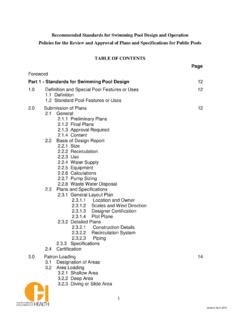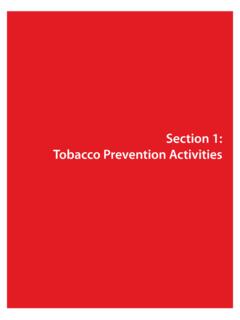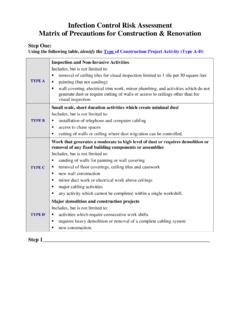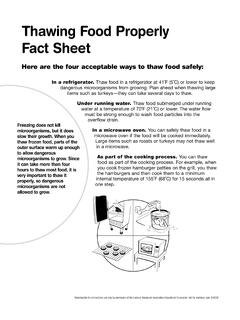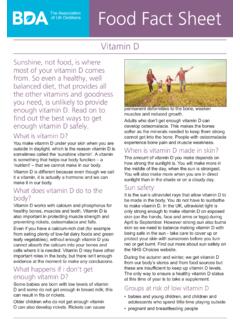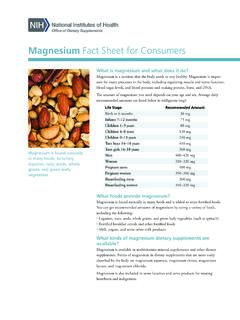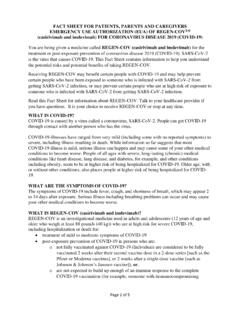Transcription of Food Code Fact Sheet: Date Marking Ready to Eat Hazardous ...
1 Date Marking & Disposal of Ready to Eat Potentially Hazardous food food Code fact sheet #8 What is date Marking and how is it used? Date Marking is a tool to help ensure food safety. It is also a license requirement. Date Marking is an identification system for Ready -to-eat foods held over 24 hours, so you know how old they are. The system helps to identify either when the food was prepared, or when it is to be discarded. Refrigerated, Ready -to-eat, potentially Hazardous food prepared and held for more than 24 hours in a food establishment must be marked with the date of preparation and must be discarded if not consumed within 7 calendar days from the date of preparation. A container of refrigerated, Ready -to-eat, potentially Hazardous food prepared and packaged by a food processing plant must be marked to indicate the date by which the food must be consumed or it must be consumed or discarded within 7 calendar days after the original package is opened in a food establishment.
2 This requirement does not apply to whole, unsliced portions of a cured and processed product with the original casing maintained on the remaining portion, such as bologna, salami, or other sausage in a cellulose casing. What foods need to be date marked? 1. Does the food require refrigeration?2. If commercially packaged, has the original package been opened?3. Is the food Ready -to-eat? Could this food be eaten just like it is, regardless of temperature?Examples of Ready -to-eat foods include: cold, cooked roast beef and cold, cooked macaronis casserole. 4. Is the food potentially Hazardous ? Will it mold, or grow bacteria? Will the food supportbacterial or viral foodborne organism growth? Example, listeria monocytogenes isassociated with soft Will the food be in the establishment for more than 24 hours?
3 This counts even if the foodis, or will be, mixed with something else to form a new you answered YES to all 5 of these questions, then the food needs to be date marked. When to discard? Refrigerator is at 41 F or below = discard within 7 days Facts to be aware of: If the food has an expiration date on it, isn t that the same as a date mark? No, the expiration date is the date through which the manufacturer guarantees the food will meet their quality standards. Date Marking for discard ensures the safety of the food . The establishment goes through this food so fast, if it is going to be gone in less than 7 days. Do I still need to date mark it? Yes, if the food is not going to be served or discarded within 24 hours, it must be date marked. What if I freeze the food ? Freezing food stops the date Marking clock but does not reset it.
4 So, if a food is stored at 41 F for 2 days and then frozen, it can still be stored at 41 F for 5 more days when it begins to thaw. The freezing date and the thawing date need to be put on the container along with the prep date, or an indication of how many of the original 7 days have been used. If food is not dated with these dates, it must be used or discarded. What if the food item is packaged for self-service? The date Marking requirements apply whether the Ready -to-eat potentially Hazardous food is sold from a service case, repackaged for self-service or consumed on-site. What date applies when a salad bar offering is refreshed? If Ready -to-eat potentially Hazardous foods are refreshed, as in a service case or salad buffet, the date Marking for the oldest product in the container must not be exceeded.
5 What date applies when a pre-cooked ingredient is used to make a salad? When cooked product is held in refrigeration for additional preparation at a later date, the seven-day rule begins at the end of the initial key step. For example, in the case that potatoes are cooked for potato salad or roast chicken prepared for chicken salad, if the potatoes or chicken are held for two days after cooking and then processed into salads, these salads must be consumed within five days so as to not exceed the seven-day rule. If the cooked products were cooled and reheated, the clock starts over after is has been reheated to 165 F (kill step). What if I mix the food with something else? When foods are mixed together the date of the oldest food becomes the new date for the mixed food .
6 Example, if today is Wednesday, and you are mixing a food that was marked on Monday with a food that was marked on Tuesday, the mixed food Marking would be based on the starting date of Monday. Are there any exceptions? Yes. Uncut portions of processed cured meats packaged in cellulose, like salami and bologna do not need tobe date marked. Hard cheeses like Asiago old, Cheddar, Gruyere, Parmesan, Romano, andSapsago do not need to be date marked. Semi-soft cheeses like Asiago fresh, Soft, Blue, Brick, Colby, Edam, Gouda,Monterey, Pasteurized processed cheese, Provolone and Swiss do not need to bdate Soft cheeses like Brie, Cotijo, Ricotta and Teleme must be date marked. Commercial acidified dressing like mayonnaise and Thousand Island do not need to be date dressings must be date Dakota Office of Health Protection June 28, 2004

